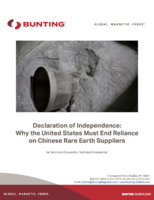Reference Material addresses hexavalent chromium in soil.
Share:

Press Release Summary:

Developed in collaboration with EPA and NJDEP, certified reference material aids in detection and measurement of carcinogen hexavalent chromium in soil, providing benchmark for measurements needed to guide and assess cleanup efforts. Source material was collected from waste site in Hudson County, NJ. After milling, blending, and sterilizing, scientists analyzed samples for hexavalent chromium using EPA-approved methods designed to minimize and compensate for chemical properties of chromium.
Original Press Release:
New Reference Material for Hexavalent Chromium in Contaminated Soil
The National Institute of Standards and Technology (NIST) has issued a new standard-a certified reference material-to aid in the detection and measurement of the potent carcinogen hexavalent chromium in soil. Developed in collaboration with the Environmental Protection Agency (EPA) and the New Jersey Department of Environmental Protection (NJDEP), the new reference material will provide a crucial benchmark for the high-quality chemical measurements needed to guide and assess cleanup efforts.
Chromium, familiar to most people as the shiny, highly polished metal known simply as chrome, is found in products ranging from automobiles to stainless steel. Chromium can occur in a number of different chemical forms including trivalent chromium, a micronutrient, and hexavalent chromium. The processing of chromium ores can extract portions of these species for use in other industrial processes, as an anti-corrosion agent, and in paints, dyes and leather tanning. Reprocessed waste, consisting of a mix of trivalent and hexavalent chromium containing compounds, was dumped in sites around the country during the 1940s and 1950s. In New Jersey alone, authorities have identified more than 160 sites in need of cleanup.
However, cleanup efforts are complicated by the fact that interactions with components in the soil such as organic carbon and iron, as well as and the acidity of the soil can cause either of these two forms of chromium to convert to the other. This complicates laboratory measurements and makes it difficult to accurately quantify the original concentration of each species in the soil. The uncertainty hampers regulatory agencies in making decisions about which sites need to be cleaned up-if a site is misidentified as contaminated, expensive remediation efforts will be wasted, and if a site is misidentified as uncontaminated, the health of local residents could be at risk.
To aid in reducing the uncertainty surrounding these important measurements, NIST scientists have prepared and assigned certified values for Standard Reference Material (SRM) 2701, Hexavalent Chromium in Contaminated Soil, High Level (https://s.nist.gov/srmors/view_detail.cfm?srm=2701). The source material for the new SRM was collected from a waste site in Hudson County, N.J. After milling, blending, and sterilizing, scientists analyzed the samples for hexavalent chromium using several EPA-approved methods designed to minimize and compensate for the chameleon-like chemical properties of chromium.
The contaminated soil SRM has been assigned certified values for hexavalent chromium, total chromium, iron and manganese as well as reference values for other elements of environmental interest including aluminum, calcium, magnesium, nickel, silicon, sulfur, titanium and vanadium.
Standard Reference Materials are among the most widely distributed and used products from NIST. The agency prepares, analyzes and distributes more than a thousand different materials that are used throughout the world to check the accuracy of instruments and test procedures used in manufacturing, clinical chemistry, environmental monitoring, electronics, criminal forensics and dozens of other fields. For more information, see NIST's SRM Web page at http://ts.nist.gov/measurementservices/referencematerials.




